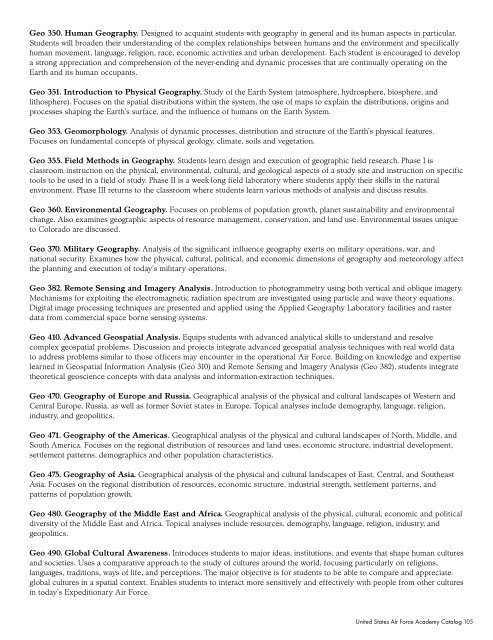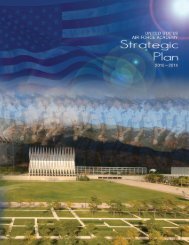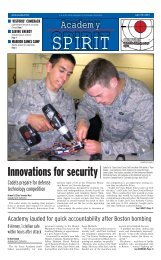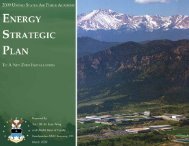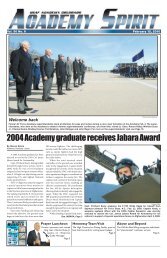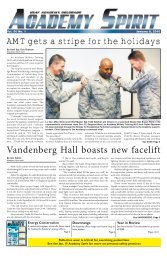2008-2009 Catalog - United States Air Force Academy
2008-2009 Catalog - United States Air Force Academy
2008-2009 Catalog - United States Air Force Academy
You also want an ePaper? Increase the reach of your titles
YUMPU automatically turns print PDFs into web optimized ePapers that Google loves.
Geo 350. Human Geography. Designed to acquaint students with geography in general and its human aspects in particular.<br />
Students will broaden their understanding of the complex relationships between humans and the environment and specifically<br />
human movement, language, religion, race, economic activities and urban development. Each student is encouraged to develop<br />
a strong appreciation and comprehension of the never-ending and dynamic processes that are continually operating on the<br />
Earth and its human occupants.<br />
Geo 351. Introduction to Physical Geography. Study of the Earth System (atmosphere, hydrosphere, biosphere, and<br />
lithosphere). Focuses on the spatial distributions within the system, the use of maps to explain the distributions, origins and<br />
processes shaping the Earth’s surface, and the influence of humans on the Earth System.<br />
Geo 353. Geomorphology. Analysis of dynamic processes, distribution and structure of the Earth’s physical features.<br />
Focuses on fundamental concepts of physical geology, climate, soils and vegetation.<br />
Geo 355. Field Methods in Geography. Students learn design and execution of geographic field research. Phase I is<br />
classroom instruction on the physical, environmental, cultural, and geological aspects of a study site and instruction on specific<br />
tools to be used in a field of study. Phase II is a week-long field laboratory where students apply their skills in the natural<br />
environment. Phase III returns to the classroom where students learn various methods of analysis and discuss results.<br />
Geo 360. Environmental Geography. Focuses on problems of population growth, planet sustainability and environmental<br />
change. Also examines geographic aspects of resource management, conservation, and land use. Environmental issues unique<br />
to Colorado are discussed.<br />
Geo 370. Military Geography. Analysis of the significant influence geography exerts on military operations, war, and<br />
national security. Examines how the physical, cultural, political, and economic dimensions of geography and meteorology affect<br />
the planning and execution of today’s military operations.<br />
Geo 382. Remote Sensing and Imagery Analysis. Introduction to photogrammetry using both vertical and oblique imagery.<br />
Mechanisms for exploiting the electromagnetic radiation spectrum are investigated using particle and wave theory equations.<br />
Digital image processing techniques are presented and applied using the Applied Geography Laboratory facilities and raster<br />
data from commercial space borne sensing systems.<br />
Geo 410. Advanced Geospatial Analysis. Equips students with advanced analytical skills to understand and resolve<br />
complex geospatial problems. Discussion and projects integrate advanced geospatial analysis techniques with real world data<br />
to address problems similar to those officers may encounter in the operational <strong>Air</strong> <strong>Force</strong>. Building on knowledge and expertise<br />
learned in Geospatial Information Analysis (Geo 310) and Remote Sensing and Imagery Analysis (Geo 382), students integrate<br />
theoretical geoscience concepts with data analysis and information-extraction techniques.<br />
Geo 470. Geography of Europe and Russia. Geographical analysis of the physical and cultural landscapes of Western and<br />
Central Europe, Russia, as well as former Soviet states in Europe. Topical analyses include demography, language, religion,<br />
industry, and geopolitics.<br />
Geo 471. Geography of the Americas. Geographical analysis of the physical and cultural landscapes of North, Middle, and<br />
South America. Focuses on the regional distribution of resources and land uses, economic structure, industrial development,<br />
settlement patterns, demographics and other population characteristics.<br />
Geo 475. Geography of Asia. Geographical analysis of the physical and cultural landscapes of East, Central, and Southeast<br />
Asia. Focuses on the regional distribution of resources, economic structure, industrial strength, settlement patterns, and<br />
patterns of population growth.<br />
Geo 480. Geography of the Middle East and Africa. Geographical analysis of the physical, cultural, economic and political<br />
diversity of the Middle East and Africa. Topical analyses include resources, demography, language, religion, industry, and<br />
geopolitics.<br />
Geo 490. Global Cultural Awareness. Introduces students to major ideas, institutions, and events that shape human cultures<br />
and societies. Uses a comparative approach to the study of cultures around the world, focusing particularly on religions,<br />
languages, traditions, ways of life, and perceptions. The major objective is for students to be able to compare and appreciate<br />
global cultures in a spatial context. Enables students to interact more sensitively and effectively with people from other cultures<br />
in today’s Expeditionary <strong>Air</strong> <strong>Force</strong>.<br />
<strong>United</strong> <strong>States</strong> <strong>Air</strong> <strong>Force</strong> <strong>Academy</strong> <strong>Catalog</strong> 105


